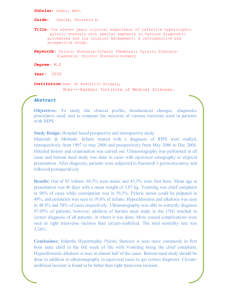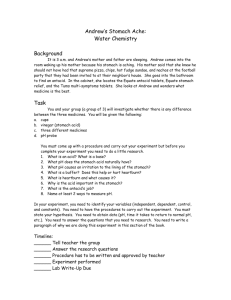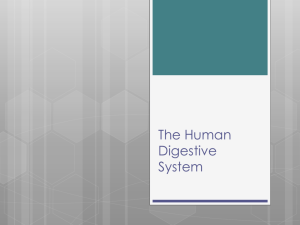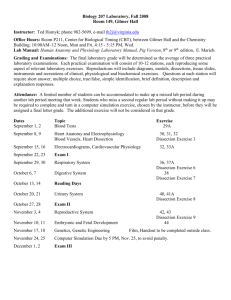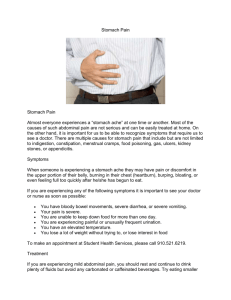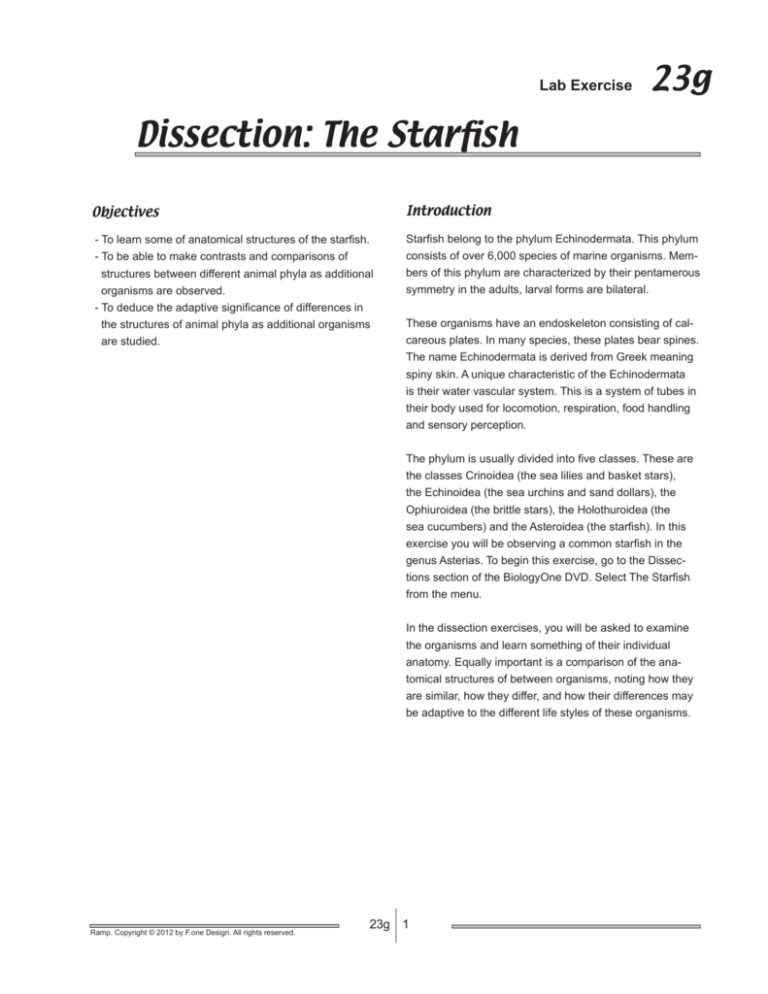
Lab Exercise
23g
Dissection: The Starfish
Objectives
Introduction
- To learn some of anatomical structures of the starfish.
- To be able to make contrasts and comparisons of
structures between different animal phyla as additional
organisms are observed.
- To deduce the adaptive significance of differences in
the structures of animal phyla as additional organisms
are studied.
Starfish belong to the phylum Echinodermata. This phylum
consists of over 6,000 species of marine organisms. Members of this phylum are characterized by their pentamerous
symmetry in the adults, larval forms are bilateral.
These organisms have an endoskeleton consisting of calcareous plates. In many species, these plates bear spines.
The name Echinodermata is derived from Greek meaning
spiny skin. A unique characteristic of the Echinodermata
is their water vascular system. This is a system of tubes in
their body used for locomotion, respiration, food handling
and sensory perception.
The phylum is usually divided into five classes. These are
the classes Crinoidea (the sea lilies and basket stars),
the Echinoidea (the sea urchins and sand dollars), the
Ophiuroidea (the brittle stars), the Holothuroidea (the
sea cucumbers) and the Asteroidea (the starfish). In this
exercise you will be observing a common starfish in the
genus Asterias. To begin this exercise, go to the Dissections section of the BiologyOne DVD. Select The Starfish
from the menu.
In the dissection exercises, you will be asked to examine
the organisms and learn something of their individual
anatomy. Equally important is a comparison of the anatomical structures of between organisms, noting how they
are similar, how they differ, and how their differences may
be adaptive to the different life styles of these organisms.
Ramp. Copyright © 2012 by F.one Design. All rights reserved.
23g 1
Activity 23g.1
External Anatomy
Activity 23g.2
Internal Anatomy
From the introductory screen, click on the forward arrow in
the lower right to examine the top or aboral surface of the
starfish. Note its five arms giving the starfish its pentamerous symmetry. The central region of the starfish to which
the arms attach is called the central disc. Off center on
central disc should be able to see a light colored circle.
This is the madreporite. It is a porous structure that allows
water to enter the water vascular system.
Turn the starfish so you are viewing its aboral side. To
begin the dissection to observe the internal anatomy of the
starfish, use your scissors to remove the top of one of the
arms. Click on the forward arrow to complete this dissection.
Located in the center of the central disc is the anus. One
can usually not find the anus without magnification.
Turn the starfish over to observe the oral side by clicking
on the small starfish located in the lower right. Find the
mouth located in the center of the central disc. The mouth
is surrounded by a soft membrane called the peristome
and specialized oral spines. Radiating away from the
mouth are the five ambulacral grooves that extend to the
tips of the arms. Within these grooves are numerous tube
feet. The starfish is able to extend these out from the
ambulacral groove and attach them to the substrate with a
sucker-like action. At the tips of each groove there is also
a light sensitive pigmented eye spot and a specialized
sensory tentacle. These structures are difficult to observe
in preserved specimens.
After studying the external features of the starfish, label
the illustration located in the Results Section.
Look at the cut surface of the arm. You should be able to
see small white plates just below the body surface. These
are the calcareous plates or ossicles of the endoskeleton.
You may observe the spike-like projections in some of
these.
Extending down the length of each arm is a pair of highly
branched pyloric caecae. These are the starfish’s digestive glands. Where the pyloric caecae of an arm enter
the central disc, the pair joins into a common tube that
attaches to the pyloric stomach within the central disc. The
pyloric caecae secrete digestive enzymes and also play
a major role in absorbing digested food. After observing
these structures, cut the pyloric caecae away to expose
the structures below. Click on the forward arrow in the
lower right to complete this dissection.
Below the pyloric caecae lies a pair of gonads in each
arm. When the starfish are in season, the gonads enlarge
and fill a large space within the arms. Out of season the
gonads are smaller in size, only extending a short distance down each arm. Although the starfish has separate
sexes, it is very difficult to distinguish between them without microscopic examination. The gonads lead to a duct
the releases the gametes into the seawater. Fertilization
occurs in the water column.
In this specimen, the gonads only extend a short distance
down the arm. Beyond the end of the gonads, you can
observe masses of bumpy structures that extend down the
arm on either side of the midline. These bumpy structures
are the bulbous tops of the tube feet. These are called
ampulla. The ampulla attach by lateral canals to the radial
canal that extends down the arm along its midline, along
the top of the ambulacral groove.
Ramp. Copyright © 2012 by F.one Design. All rights reserved.
23g 2
Having observed the structures of the arms, now observe
the internal structures of the central disc by carefully removing the aboral surface with your scissors. Click on the
forward arrow in the lower right to complete this dissection. With the top of the central disc removed, you should
be able to observe the two chambered stomach of the
starfish.
The smaller, thick walled pyloric stomach lies above the
larger, thin walled cardiac stomach. The pyloric caecae in
the arms connect to the pyloric stomach. From the pyloric
stomach, wastes are expelled from the body through a
short intestine that leads to an anus on the aboral side of
the central disc. The starfish is able to invert its cardiac
stomach out through its mouth to envelop its prey and
engulf it whole. Indigestible parts are not passed on to the
pyloric stomach but instead are regurgitated.
Remove the pyloric stomach to better observe the cardiac
stomach. Complete this dissection by clicking on the
forward arrow in the lower right. After observing the pyloric
and cardiac stomachs, remove the cardiac stomach to
observe the structure below. Complete this dissection by
clicking on the forward arrow in the lower right.
Below the cardiac stomach you can observe the circular
or ring canal of the water vascular system that circles the
mouth. The radial canals that extend out each arm connect to this ring canal. Extending up from the ring canal is
a tube called the stone canal. This connects to the madreporite. Water can be drawn into the water vascular system
through the madreporite, down the stone canal and into
the ring canal. Here the fluid is distributed among the radial canals. Ultimately, by controlling the pressures within
the water vascular system as well as through muscular
control, the starfish is able to manipulate its tube feet.
After studying the internal features of the starfish, label the
illustration located in the Results Section.
Ramp. Copyright © 2012 by F.one Design. All rights reserved.
23g 3
Lab Exercise
23g
Name _______________________
6. _____________________
3. _____________________
Ramp. Copyright © 2012 by F.one Design. All rights reserved.
7. _____________________
4. _____________________
2. _____________________
1. _____________________
Activity 23g.1 & 2
External and Internal Anatomy
5. _____________________
Results Section
23g 4

